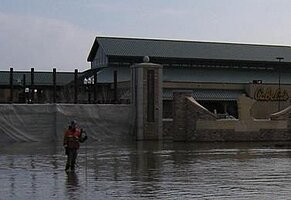Improving the Use of Acoustic Doppler Velocity Meters (ADVMs) in the Estimation of River Discharge

Brent Hanson is originally from Halliday, ND. In May of 2003 he received a B.S degree in Civil Engineering from North Dakota State University. He is currently pursuing an M.S. degree in Water Resource Engineering at NDSU. Brent intends to graduate in December 2006.
brent_hanson_ndsu@yahoo.com
Fellow: Brent R. Hanson, Water Resource Engineering Program, Department of Civil Engineering, NDSU
Advisor: Wei Lin, Assistant Professor of Civil Engineering, NDSU
Degree Progress: M.S. expected in December 2006.
Improving the Use of Acoustic Doppler Velocity Meters (ADVMs) in the Estimation of River Discharge.
Water is an important resource that affects everyone by its quantity. From times of drought to the times of flooding, it is important to continuously monitor the real-time discharge of our rivers and streams. This is so proper tactics can be instigated to best manage droughts, water distribution, and flood control. The US Geological Survey (USGS) is one government agency that plays major role in providing discharge data for the rivers and streams within the US. To improve the accuracy of real-time discharge estimates, the USGS is continuously implementing the latest technology. Recently there has been an increasing interest in the use of hydroacoustic principles to monitor water flow. One system that uses these principles is the Acoustic Doppler Velocity Meter (ADVM).
An ADVM provides a noninvasive measurement of velocity within a sample volume of a stream or river. The meter obtains this “index” velocity by means of acoustic transducers. The transducers measure the velocity by bouncing sound waves off particles carried in the water. The ADVM then uses the shift in frequency (Doppler Effect) of the returning sound waves to estimate an index velocity for the channel’s flow. This index velocity can then be related to the channel’s mean velocity to develop an index-mean velocity rating. After the velocity rating is developed, the index velocity can then be continuously monitored to estimate the channel’s mean velocity.
Continuous monitoring of velocity and stage can then be used to provide real-time estimates of the channel’s discharge.
Research:
The current method of developing an index-mean velocity rating is done empirically by taking simultaneous measurements of the index and mean velocities. Depending on channel geometry, these ratings can show a linear trend or more of a parabolic type relation. Therefore, for early use of the ADVM’s index velocities, there needs to be a theoretical method of modeling the index-mean velocity relation.
Analysis of past ADVM data collected at selected USGS gaging stations has shown that a relation between the channel’s mean velocity and the index velocity along with stage and area that is independent of the cross-sectional geometry. Based on this analysis, the following theoretical equation was developed.
![]()
Where V m is the mean channel velocity in ft/s, K is a constant, V i is the ADVM’s index velocity in ft/s, h is the water’s stage in ft, and A is the cross-sectional area of the flow in ft 2.
The constant (K) within the equation is site specific. This value has been calculated for the selected sites using past data. The calculated K accurately models the velocity relations previously developed empirically. Further studies need to be carried out to determine the meaning of K. After determining what K represents, this equation can be used to develop a theoretical model of the velocity rating. This will enable the use of the ADVM for discharge estimates at the time of installation.


Wei Lin
Civil & Environmental Eng.
Office: Civil/Ind Eng 201D
Telephone: 701-231-6288
Email: wei.lin@ndsu.edu


